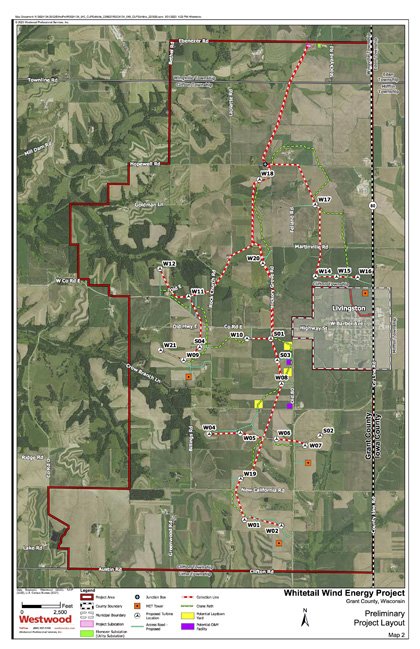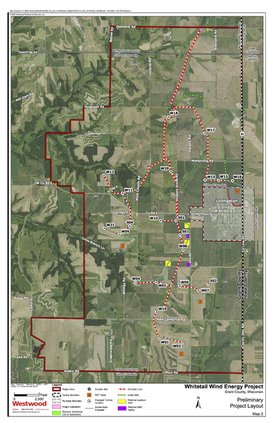SOUTHWEST WISCONSIN - Attorney Martin Machtan has a strategy for fighting wind farm projects like the three proposed in Lafayette, Iowa and Grant counties:
Become, as Machtan put it in the Belmont Convention Center Monday night, a “hard target for the wind companies.”
An estimated 400 people from townships where wind farm projects are proposed heard Machtan describe legal and political ways to at least slow down wind projects through town ordinances.
Not attending the meeting, though Machtan said they were invited, were representatives of the three companies with proposed wind farm projects.
“That kind of tells you everything you need to know,” he said.
Stricter ordinances make a particular project less likely for developers to pursue.
“We’ve been told they have almost unlimited money,” he said. “That’s true, but the don’t have unlimited energy or unlimited employees.
“We would not be doing this if we didn’t have confidence this would be effective. Buying time is so important. The developers don’t have time, and we do.”
Machtan’s Central Wisconsin organization Farmland First was successful in getting 14 townships in Clark and Marathon counties to adopt health and safety ordinances that are restrict wind farm projects more than state law specifies and more than county boards have been doing.
Those health and safety ordinances require a township adopt village powers if the town doesn’t have village powers already. He said under state law village powers can be enacted without town board approval if a special meeting of town residents is called.
Machtan said town residents have “dramatically more power than you realize” if they petition their town boards to enact health and safety ordinances similar to the ordinances approved by the townships, citing the Marathon County Town of Cassel.
The health and safety ordinances increase the allowable setback for wind turbines under state regulation from the current 1,250 feet from a residence and 1.1 times the height of the turbine from the residence’s property line.
Machtan believes the town health and safety ordinances are necessary to counteract what he calls “extremely unfair” and “one-sided” contracts between developers and landowners.
“We understand needing another source of revenue,” he said. “We understand how difficult farming is. … If [farmland] goes away, we don’t see it coming back.”
Machtan believes — and has language from contracts between wind farm developers and landowners to prove it — the easement contracts give almost all rights to the developers in return for significant restrictions on and uncertain financial returns for landowners, giving them “an unreasonable amount of risk.”
The meeting comes as three wind farm projects are proposed in Southwest Wisconsin. The largest project, Pattern Energy’s Uplands Wind project in Lafayette and Iowa counties, already has 71 easement contracts, according to a member of the audience.
A Pattern Energy representative said last week that the company has not determined the size or maximum turbine height of Uplands Wind.
Allete Energy also has the Whitetail Wind project proposed in Livingston, and Invenergy has a project proposed east of Livingston.
The Grant County Conservation, Sanitation and Zoning Committee will hold a meeting including the Whitetail Wind project I the Administration Building in Lancaster July 6 at 9 a.m.
Any wind energy project must be approved by the state Public Service Commission.
“You can’t trust any of these companies,” said Machlan, listing their ownership by Canadian pension funds in two cases and their private equity ownership in all three companies. “You’re no longer in control of your own property. … These are investment vehicles; this is not about clean and green energy.”
Contract provisions usually cover the landowner’s entire property, not just where turbines are located, and restrict landowner use while allowing developers “sole discretion” in installing turbines and roads wherever and whenever they want, he said. The contracts also allow “pretty much unlimited tree-cutting” while restricting landowners’ ability to plant trees.
Machtan said Allete contracts encumber landowners up to 50 years, Pattern 40 to 50 years, and Invenergy 37 years. The developers, however, can get out of those contracts quickly, he said.
“Those financial benefits are not real if they last for a total of zero months or two months,” he said.
One contract he saw increased payments to the landowner by 1 to 1.5 percent per year, which he said is a fraction of the current inflation rate.
Machtan said standards for decommissioning wind projects are “wholly inadequate, and the contracts are worse.”
All three companies’ contracts also include nondisclosure requirements or clauses that prohibit the landowner from disparaging the company, he said.
Machtan said “very credible research” shows property losses of 5 to 40 percent for properties with wind farm easements. He said banks elsewhere in the U.S. have been refusing to allow farmers to use their land with wind project easements to be used as collateral for loans.”
While Machlan said he has a solar array on his farm west of Marshfield, he terms renewable energy “intermittent unreliable power,” citing a North American Electric Reliability Corp. study that use of renewables to replace power plants going offline will make Wisconsin energy supplies as unreliable as California’s now are within a decade.
“We can’t afford for Wisconsin to not have the ability to provide the goods we produce, to provide the food we produce,” he said. “We’re strong supporters of clean energy, but it’s hard to know what that is.”
Machtan’s wife, Barb, listed studies about the health hazards of infrasound, which cannot be heard — wind turbines are regulated to be no louder than 50 decibels during the day and 45 decibels at night — but can be felt by humans and animals. Infrasound is created by a wind turbine’s blades passing over the turbine’s pylon.
She cited a Fond du Lac County farmer whose chickens began being born with birth defects and producing fewer eggs when a wind farm project went online. Another study she cited claimed that earthworms leave areas where wind turbines are located, negatively affecting soil health.
Barb Machtan also noted studies showing health problems caused by blade flicker and glare caused by the sun, as well as unsynchronized red lights that flash from the turbines at night.
Another meeting for wind turbine opponents targeted toward Town of Clifton residents will be held in the Livingston–Clifton Fire Station in Livingston Friday at 7 p.m. The meeting is being held by a group called Concerned Citizens Opposing Wind Turbines.




